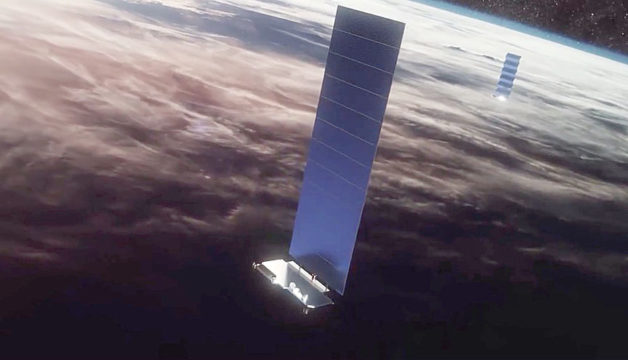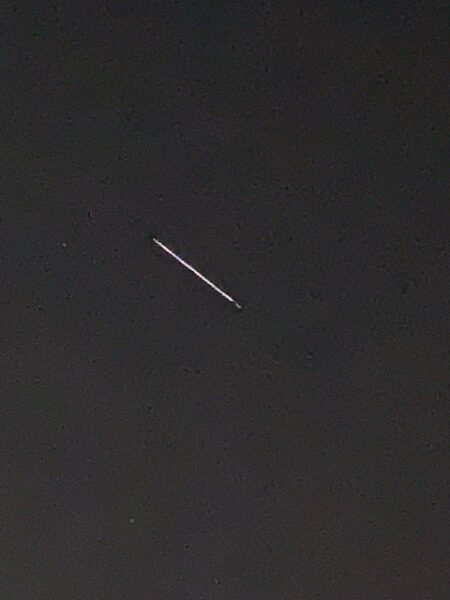Newest Starlink Satellites Have Gotten Brighter Again – Sky & Telescope

SpaceX
SpaceX has launched more than 2,000 Starlink internet satellites since 2019, and the company plans to orbit thousands more in the near future. Astronomers are concerned that these megaconstellations of bright spacecraft will seriously interfere with celestial observations for professionals and amateurs alike.
In order to address the problem, SpaceX voluntarily began installing sunshades on their Starlink satellites two years ago. These so-called VisorSats are about 1.3 magnitudes dimmer than the original satellites, as reported in Sky & Telescope. But now, new technological requirements have resulted in visors being omitted from a new generation of Starlink satellites launched since late last year. Alexandra Witze reported in Nature that the newest satellites use laser communication instead of radio links; while the sunshades were transparent to radio frequencies, they block laser light.
SpaceX engineer David Goldstein discussed these design changes at a recent webinar organized by the Federation of Astronomical Societies, adding that the company has developed dielectric mirrors for the Earth-facing side of the Starlink chassis, designed to reflect sunlight away from observers directly below the spacecraft.
In order to test how the brightness of the latest Starlink spacecraft (those with ID numbers above 3000) compare to VisorSats, I analyzed magnitudes recorded this year by Jay Respler, an accomplished satellite observer. The average visual magnitude measured for 58 Series-3000 satellites is 5.60, brighter than the average magnitude of 6.29 measured for 44 VisorSats.
Both a satellite’s distance from the observer and its angle relative to the Sun influence its brightness. After adjusting the observed magnitudes for these parameters, I found that the Series-3000 spacecraft are about 60% brighter than VisorSats. And even the VisorSat design had still exceeded the 7th-magnitude limit recommended by astronomers to minimize both interference with research and naked-eye enjoyment of the night sky. However, the Series-3000 satellites still represent an improvement of about 0.8 magnitudes compared to the original Starlink satellites.

Anthony Mallama
It’s worth noting that Starlink satellites can sometimes appear far brighter than mentioned already, shortly after they’re launched in batches of 50 or so. One recent sighting was reported by WKBN News in northeast Ohio. Dozens of members of the public alerted the media outlet after seeing a line of bright lights in the sky on the evening of April 21st. Those lights turned out to be Starlink satellites from the group designed G4-14, which had launched earlier that day.
Amateur astronomer, Gus Saikaly, described his view of G4-14 to me and sent the photograph below. He estimated the satellites’ individual magnitudes as -3 and likened them to a “string of Jupiters.” Such a dazzling train of spacecraft would spoil observations of almost any astronomical object.

In another worrisome development, SpaceX plans an entirely new version of Starlink that’s larger than the current model. In this video, SpaceX CEO Elon Musk announced that Starlink 2.0 would be 7 meters long and weighs 1.25 tons. The new model is so large and heavy that it will require a bigger and more powerful rocket than the Falcon 9, which currently launches the satellites. The Starlink 2.0 spacecraft will instead fly on SpaceX’s super heavy-lift Starship rocket. While their design will take light reflection into account, these future Starlinks could nevertheless end up exceeding the brightness of current ones.
Astronomers, Unite
Astronomers are not sitting by idly while SpaceX and other space-internet companies such as OneWeb populate the sky with spacecraft. The International Astronomical Union is establishing a Centre for Protection of the Dark and Quiet Sky from Satellite Constellation Interference. This web-based resource, under the management of astronomers Piero Benvenuti, Connie Walker and Federico Di Vruno, will serve as a resource for all stakeholders in the effort to preserve dark skies. The Centre will be a vital hub for astronomers as other entities including Amazon and the Chinese government pursue their own plans for space-based internet infrastructures.
Read More: Newest Starlink Satellites Have Gotten Brighter Again - Sky & Telescope

